Introduction to Orange farming project report
The following information explains about Orange farming and Orange farming project report.
Orange belongs to the citrus fruit category and is also addressed as sweet orange. It is believed that orange is a hybrid of pomelo and mandarin. Orange trees are greatly found in tropical and subtropical regions of the world and are the most cultivated fruits. This tree is not a wild species; rather it was domesticated by cross-breeding two other varieties of citrus fruits. The countries that first started orange cultivation are North Eastern India, China, and Indo-China. During the 13th century, the fruit traveled to Europe and parts of South America and Central America.
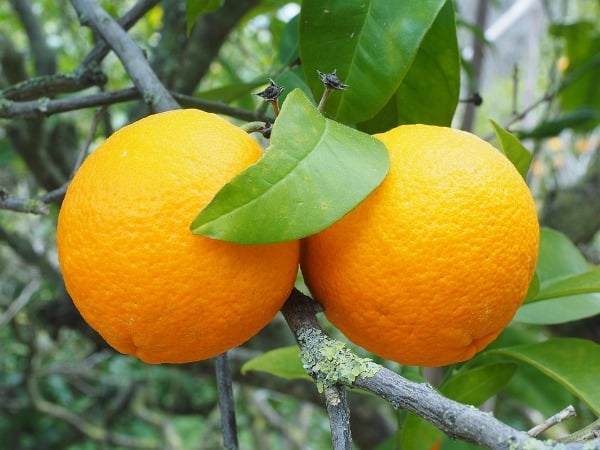
Orange plants or any other citrus plant is a modified berry and is known as a hesperidium. The fruit is covered by a peel, which originates due to the thickening of the ovary wall. This tree is evergreen in nature and is considered as a flowering variety. The average height of the tree is 9 to 10 m. The leaves of the tree are oval in shape and are arranged alternately. The fruit is either spherical or oblong in shape. There is a white bitter tissue under the peel and is called the mesocarp. The fruit has several carpels divided by membranes. The fruit is green when unripe and upon ripening it turns to yellow or bright orange in color. Common oranges, pigmented oranges, navel oranges, and acidless oranges are the four subcategories of sweet oranges.
Orange fruit properties
The taste of oranges varies depending on the sugar to acid ratio in them. It is believed that lower the ratio, the sweeter is the fruit. The most general ratio in sweet oranges is found to be 10 or 15:1. As it is a known fact that citrus fruits contain vitamin C, this is true for oranges as well because they contain 64% of vitamin C for every 100 g of the fruit. The other essential compounds found in oranges are
- Beta carotene, lutein, beta-cryptoxanthin
- Flavonoids like naringenin
- Aldehydes, esters, terpenes, alcohols, and ketones
- Fats, proteins, vitamins (A, B, C, E) and fiber
- Minerals like calcium, iron, magnesium, manganese, phosphorous, potassium and zinc
- Water up to 86%
Orange farming scope and importance in India
India is the third largest producer of oranges in the world after the US, Indonesia, and Turkey. The productivity per hectare is very low in India and it ranks 64 in this category by producing only 9.23 tonnes per hectare. India exports more than 25 thousand tonnes to countries like Bangladesh, Kuwait, and Oman, etc. It is estimated that currently, the area under orange cultivation in India has increased from 2.49 lakh hectares to 5.63 lakh hectares. Maharashtra is the leading producer of oranges accounting for 40% of the total production. Madhya Pradesh and Assam rank 2 and 3 respectively. Exports can be increased by maintaining good post-harvest management techniques. The Nagpur oranges are famous for their quality and are now being considered for the geographical indication tag. Proper loan and subsidy from the government, the introduction of new yielding varieties, availability of labor and good post-harvest management can help farmers produce good quality fruits and contribute to the economy.
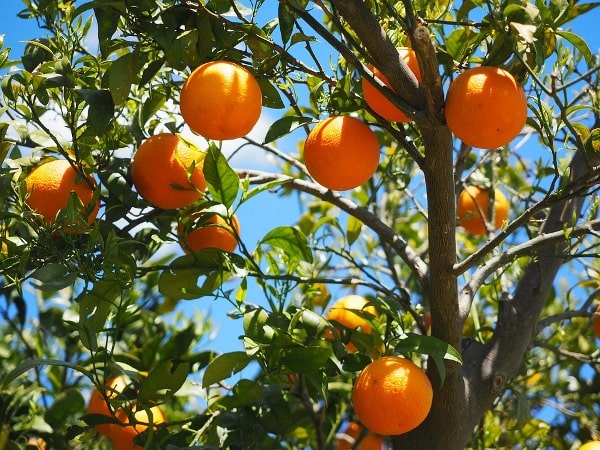
Orange varieties in India
In India, there are five different varieties of oranges being cultivated on a commercial scale. They are:
Khasi Mandarin
- It is believed to have originated from the Jayantia and Khasi hills of Meghalaya and is also found in Assam.
- The tree is medium in height, with thorns or no thorns and straight in structure.
- The fruit weight is around 140-200 g with 0.3-0.35% acidity. The color of the fruit is yellow or dark orange with a thin and tight peel. The fruits taste sweet and have thick foliage around them.
Darjeeling Santra
- This variety is grown in West Bengal mainly in the Kalimpong hill region.
- The fruit quality is similar to the Khasi Mandarin.
Nagpur Santra
- This variety was brought from Aurangabad to Nagpur during the 18th century and it is believed to have existed for 250 years in Vidarbha.
- It is spread over Maharashtra, Madhya Pradesh, some parts of Rajasthan and Uttar Pradesh. This belt of oranges from Nagpur to Amravati is generally addressed as the California of India.
- The skin of the fruit is loose. The tender pulp is saffron or orange in color with sugar acid taste and flavor.
Coorg Mandarin
- A variety of two places in South India, Karnataka, and Tamil Nadu.
- The trees are tall and have thorns. The trees have late maturity.
- Fruits of the tree are round, oblate or globose in shape with around 0.57% of acidity.
Kinnow
- It is a hybrid of two different varieties i.e. the king and willow leaf. Generally found in North-Western India.
- The trees are tall and develop a dense canopy structure.
- The color of the fruit is dark orange or sometimes red. They have thick and tight skin and are less prone to sunburn.
- It is used for the juice industry because of high yield.
The soil and climate requirements for growing Oranges
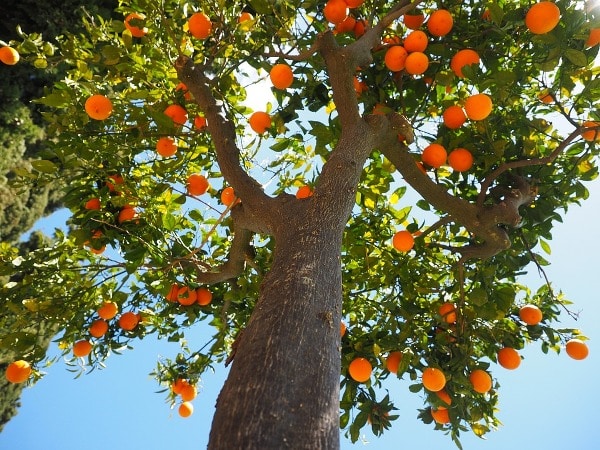
Arid and semi-arid regions of the southwest to humid tropical regions of the northeast are best suitable for orange cultivation in India. They are best suited for the subtropical type of climates where the temperature is around 13-37˚C. High humidity and frost are extremely dangerous for the plants. There could be a possible danger of fruit and flower drop due to hot winds during the summer months. Some varieties can be grown at altitudes up to 2000 m above sea level.
The soil that is best suited for orange plants should be light and well drained. Any soil such as sandy loam, alluvial, clay loam, lateritic, etc. is favorable for orange plants. The pH of the soil may be around 4 to 9 but ideally deep soil with a pH of 5.5 to 7.5 is beneficial. The soil should not have high calcium carbonate content otherwise the feeder root zone may be badly affected.
Propagation methods of Oranges
Propagation is possible through seed buds or grafts. It is believed that vegetative propagation, i.e. by budding or grafting is more preferable for cultivation because seeds take a longer time to germinate and produce fruits approximately around 8 to 10 years. While vegetative propagation produces fruits in 3 to 4 years. Generally, a bud with some bark called the budwood is removed from the tree and is inserted under the bark of a host tree. Selection of the budwood must be made from a healthy and vigorous tree during the months of April or November. The length of the budwood should be 8 to 12 inches. The rootstock plant is selected and a one-inch vertical cut is made with a sharp knife. At the bottom of the vertical cut, a horizontal cut is made such that it forms an inverted ‘T’. The budwood is then placed under the flaps of the T cut. The graft is wrapped with tapes and should be removed only after 30 days. If the bud looks healthy and green, then the graft was successful. To help the grafted region grow, 2/3 of the rootstock is cut along with the grafted region and is planted on the ground. When the bud has grown to 2 or 3 inches, the extra rootstock above the bud can be removed.
Read: Types Of Vegetative Propagation.
The land preparation and planting of Oranges
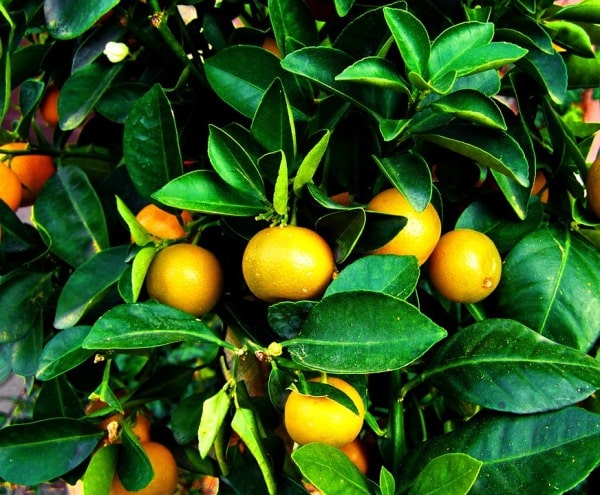
The land for orange farming has to be ploughed thoroughly and properly levelled. Pits of dimensions 1 x 1 x 1 meter are dug for planting the seedlings and each pit is filled with a mixture of 15-20 kg of FYM, 500 g of superphosphate and topsoil. The best time for planting is from June till August. The normal spacing for planting the trees is 6 x 6 m such that one hectare of land can accommodate 277 plants.
The high-density planting is practiced in hilly regions where planting is done on terraces against the slopes so as to accommodate more plants. These plants or trees are extremely sensitive to waterlogging and stagnation, so drainage channels of 3 to 4 ft depth along the slopes of the hilly regions are essential. The spacing for high-density planting is 1.8 x 1.8 m between the plants such that one hectare of land can accommodate 2990 plants.
Manure and fertilizer requirements for Orange trees
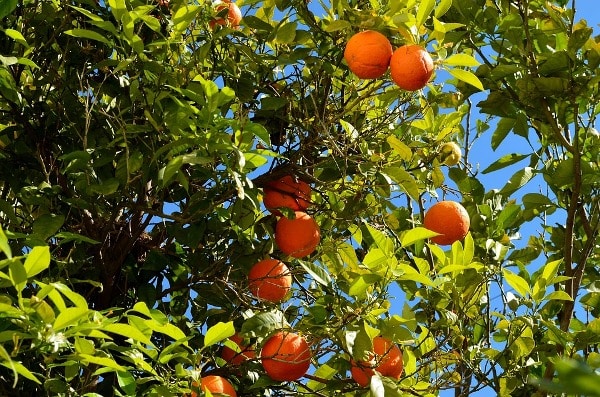
Each pit is initially supplied with a half kg of superphosphate. 20 kg of FYM per plant is required during the first year of planting and in the subsequent years, the requirement changes to 10 kg, 15 kg and 20 kg respectively. The orange tree requires an annual supplement of 100 g of nitrogen fertilizer in three split doses around the months of April, August and November and 50 g of phosphorous fertilizer in two split doses during August and November. Sometimes when the soil is black clayey, then 25 g of potassium fertilizer may be required for the plant.
The need for micronutrients is high on orange plants otherwise this may lead to disorder in fruits and lower yield. Foliar spraying of the micronutrients is generally practiced in two split doses. The important micronutrients required by the plant are zinc, manganese, and iron. Other nutrients like copper, boron, and molybdenum may also be required depending on the growth of the plants.
Read: Methods Of Guava Grafting.
Orange farming project report – irrigation requirements
The minimum water required by the plants is 900 to 1100 mm in a year. This quantity may vary for young plants and mature plants depending on the season. Irrigation is required by the plants at an interval of 10 to 15 days during winter and at an interval of 5 to 7 days during summer. Orange plants have a high water requirement when compared to other sub-tropical fruit plants. A mature orange plant on an average needs 60 to 170 liters of water in a day.
Drip irrigation is the most efficient and economical way of water supply to the plants, especially in areas with low rainfall. Care should be taken such that irrigation water doesn’t contain salts more than 1000 ppm, which may otherwise be injurious.
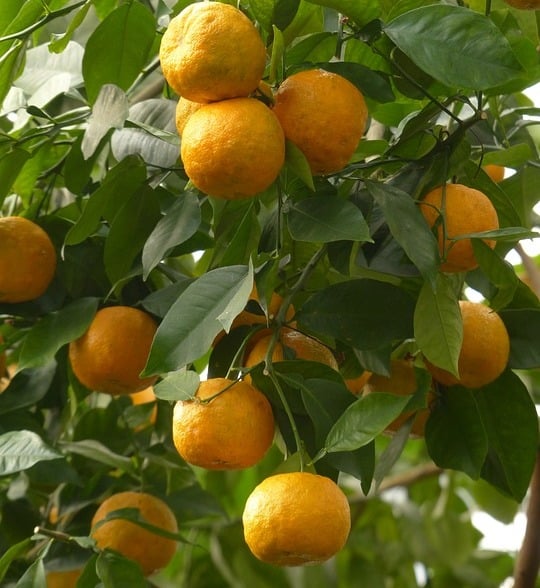
Orange farming project report – pest and disease management
Some of the common pests are citrus wooly white fly, scales, thrips, mites, mealy bugs, and nematodes. Other than these, there could also be a pest like:
Leaf miner – this pest dwells on the surface of the leaves and causes the leaf lamina to weaken. Insecticides can help control the pest.
Citrus psyllid – this pest infests the plants in the colder regions and causes pits in the leaves. The leaves ultimately start yellowing and curling up which makes the plant less productive. Pruning the infested leaves is a good solution to the problem.
Aphids – these pests also cause leaf deformation and stunted growth in twigs and can be controlled by spraying pesticides.
Orange dog – it is a caterpillar which infests the plants at all stages of growth and can be controlled by removing the areas of the plants where they are found or by spraying an insecticide would help control the pest.
The common diseases of orange plants are leaf rot, fruit rot, scab, stem rot, Phytophthora and Penicillium. They can all be controlled by using a proper fungicide. Keeping the farm clean and using disease-free varieties of planting material can be useful.
Read: Organic Cotton Farming In India.
Orange farming project report – intercultural operations
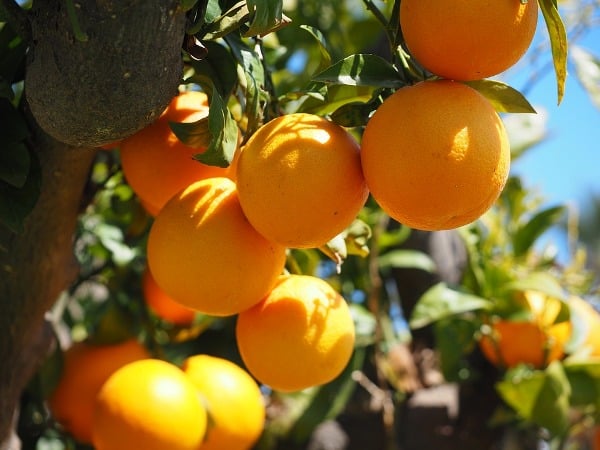
- Removal of weeds is highly recommended during the initial years of plant growth. Use of chemical weedicides or hoeing can help remove the weeds. Operations like ploughing, spading the basins, weed removal help aerate the soil and maintain its fertility.
- The basin of the plants needs to be mulched with dry leaves or paddy husk with about 8 cm of thickness so as to lessen the weed growth and retain moisture in the soil thereby improving the fruit quality.
- Intercropping with crops like gram, groundnut, cowpeas, French beans can be practiced during the initial years of orange farming. Producing legumes and vegetables can bring extra income to the farmer.
- So as to facilitate strong trunk growth, the small shoots of 40 to 50 cm length from the ground level are removed. Criss-cross twigs and water suckers have to be removed immediately during the early stages of growth. Pruning the diseased, injured and drooping branches is advisable to maintain the farm properly.
- There is a possibility of early fruit drop in most of the orange plants; therefore to correct this chemical sprays can be used three times, one during the flowering, second during the fruit-bearing season and third before the harvesting season.
Orange farming project report – harvesting and yield
Generally, orange plants produce three flushes termed as ambia bahar during Dec –Jan, mrig bahar during June- July and hastha bahar during Sept-Oct. The harvest of orange plants is done only after 3 or 4 years from planting and it is estimated that a single tree can produce 40-50 fruits. The productive life span of an orange tree is around 15 to 20 years. The full bearing capacity of the tree is attained only after 10 years. The size and color of the fruit are the main factors which indicate harvesting time. Normally it is believed that the fruits mature in 240-280 days. Harvesting is done using clippers or shears.
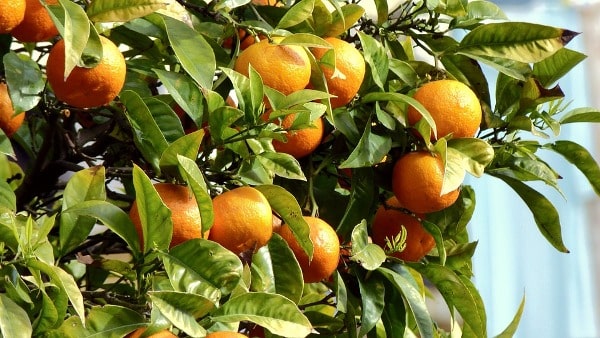
Orange farming project report – post-harvest management
- Fruits are graded according to their size and color. All the diseased, deformed, bruised and unripe fruits are sorted out.
- Ethylene gas is used for treating the unripe green oranges such that they develop yellow or orange color.
- Oranges require a temperature of 7 to 8˚C and humidity of 85-90% such that they can be stored for 4 – 8 weeks.
- The general practice is to wash the harvested fruits with chlorine and coat them with a shine wax so that the fruits look fresh. They are dried at a temperature of 50-55˚C after coating. If the fruits have to be transported over longer distances, then they are packed in wooden boxes else baskets made of bamboo and mulberry are used for packing oranges. The boxes or baskets have to be ventilated and the fruits should be wrapped in tissue paper or newspaper for protection.
Orange farming project report – economics/cost and profit analysis
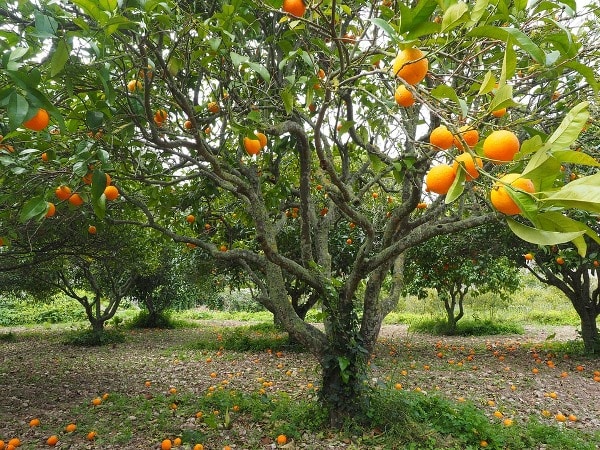
The estimation for farming oranges in a hectare of land is given here. The details or figures mentioned here are rough assumptions for the materials needed. The price of investment materials may vary depending on the area and manufacturer. It is important to make a survey in the local market before investing.
The average price of one planting material: Rs 50 (depending on the variety of the fruit the price may vary).
One hectare land needs planting material: 275.
The total cost of planting material: Rs 13,750.
Cost of labor per man-day: Rs 200.
Cost of farmyard manure: Rs 2.5/kg.
Cost of urea: Rs 5.7/kg.
Cost of superphosphate: Rs 5.8/kg.
Cost of muriate potash: Rs 16.6/kg.
Plant protection material: Rs 350/litre.
Cost of irrigation pipeline with drip facility: Rs 50,000.
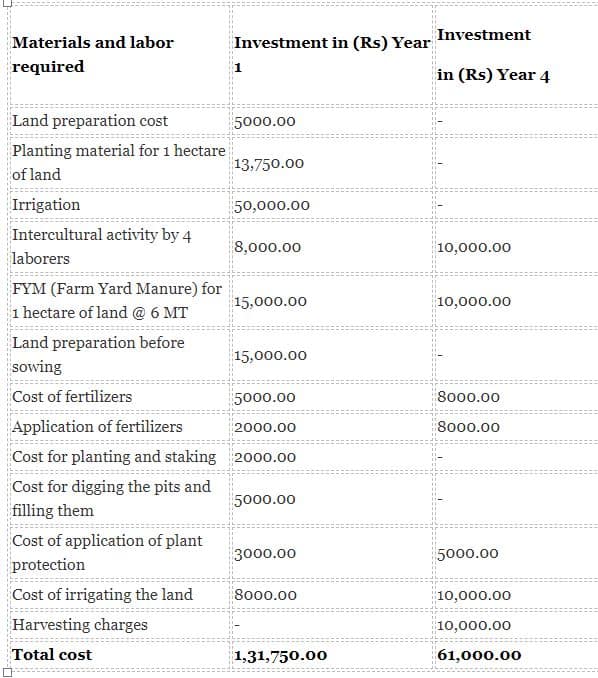
There could be some infrastructure charges like the store and pump house: Rs 30,000 (average cost).
- The labor housing charges: Rs 5000 (may vary depending on the size and material).
- Agricultural equipments: Rs 10,000.
- Fencing the land: Rs 50,000 (again, it depends on the material used for fencing).
- The investment for fertilizers, manure, labor, irrigation are all needed for the subsequent years and may cost around 30 to 50 thousand annually. The fruit is available to harvest only after 3 to 4 years of planting.
- One orange plant produces 10 kgs of fruits (approximately).
- One hectare of land produces fruits: 2750 kgs.
- Cost of 1 kg of oranges: Rs 80 (average).
Cost of 2750 kgs of oranges: Rs 2, 20,000 (this is the income generated in the 4th year of planting).
The yield of fruits increases every subsequent year and is found to be 30 kgs per plant in the next year.
So the income for the year 5 for (275 x 30) kgs of fruits is: Rs 80 x 8250 = Rs 6, 60,000.
So the profit generated is: (Income from the fruits – the expenditure on the investment material).
(Rs 2, 20,000 – Rs 61,000) = Rs 1, 59,000.
It is important to clearly note that there is no yield from the orange plants for the first 3 to 4 years, but the generation of income starts after this period.
Orange farming project report – loans and subsidies
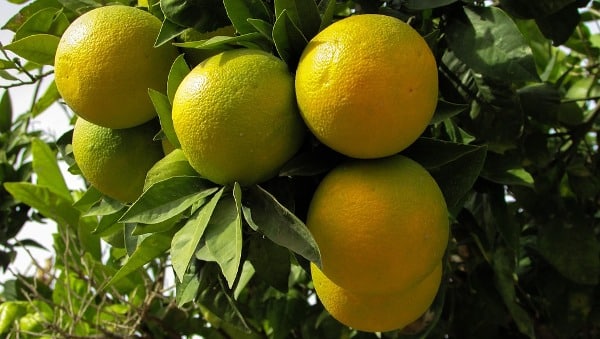
- 50% subsidy is given on the cost of cultivation for farmers who have obtained the global GAP certificate in the state of Maharashtra. This subsidy scheme is being given by Maharashtra State Agricultural Marketing Board (MSAMB), Pune on a first come first serve basis.
- It is considered that the horticulture board of every state has some subsidy scheme outlined for the farmers depending on the type of fruits favorable to be grown in that area. It is requested to either visit the horticulture board website or contact the nearest office for further information.
Orange farming project report – planting material availability
- The planting material can be obtained from ‘Nafees Nursery and Exporter’ located in Lucknow (UP, India).
- Vijaya Phyto farms in Hyderabad, Telangana is also a supplier of planting material for sweet oranges.
- The ‘agrihub’ is a place where one can find more suppliers for their specific seedling requirements.
- The local government offices for agriculture development also sometimes provide planting material.
Read: PINEAPPLE FARMING PROJECT REPORT.
Read: GROWING HERBS AND SPICES.
Sir muzhe orange fhal ka products banana hai ispar kuch malumat mil sakti kya